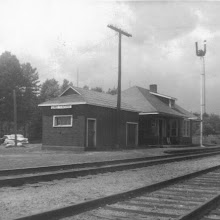
Gwen is grateful for the assistance that many of her old friends from the Lake Traverse Days provided to her while preparing her book. In particular she is grateful to Shirley Saar and Jim Gauthier.
Shirley spent part of her youth at Lake Traverse Station where her father had a lumber camp in the 1940s. She provided valuable information and interesting photos relating to Passaw's lumber camp.
Jim was born at Stuart's Spur in 1931 at the camp his father, Paul Gauthier, managed for the Pembroke Shook Mills. When Gwen moved to Lake Traverse Station, Jim's sister Irene and her husband Ray Ling were running the camp at Stuart's Spur. The Lings and the Woermkes became great friends.
You can learn more about Passaw's camp, the Pembroke Shook Mills, Stuart's Spur, and the Pembroke Lumber Company and more interesting Algonquin Park history in Gwen's book especially in Chapter 4 (Passaw's Camp at Lake Traverse), Chapter 17 (The Pembroke Lumber Company), Chapter 18 (Shooks and Wooden Boxes) and Chapter 19 (Folks Along the Line).



